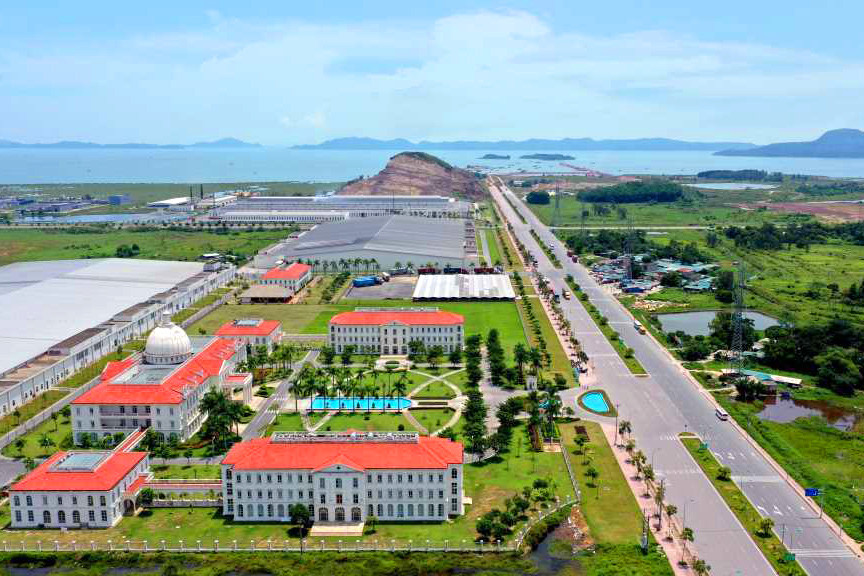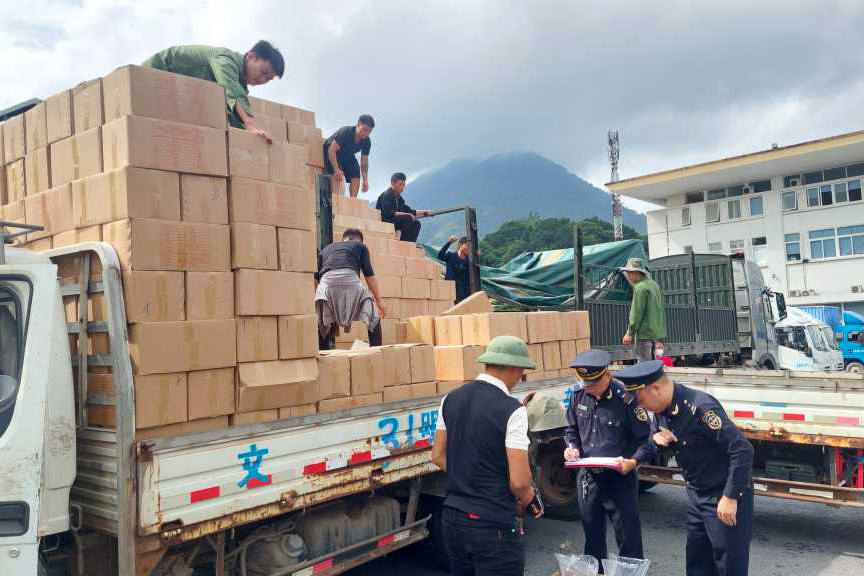
Focusing on economic restructuring
Located in the Northeast region of Quang Ninh, Hai Ha district has a total natural area of 69,013 hectares, with a 35km coastline and a 17.2km land border with China.
Hai Ha has rich natural resources, with diverse terrain such as plains, mountains and islands. It has an important political, economic and defense - security position in Quang Ninh province.
Hai Ha district has Bac Phong Sinh border gate which connects with Fangcheng district of Guangxi province (China). The Hai Ha Seaport Industrial Park connects with Van Don Economic Zone and Mong Cai Border Gate Economic Zone, which has brought many potentials and advantages for local socio-economic development.
On August 29, 2001, the Government issued Decree No. 59/2001/ND-CP dividing Quang Ha district into the two districts of Hai Ha and Dam Ha.
At the time of separation, Hai Ha district faced many difficulties as it was a purely agricultural locality, with agriculture, forestry and fishery sectors accounting for over 80% of its economic structure, the annual economic growth rate of only 3-5%, average income per capita of about 5 million VND/year, and the rate of poor households of over 18%.

After the first 10 years after the separation, Hai Ha district grew by nearly 4 times. The poverty rate decreased to 14.74%; The material and spiritual life of the people were improved remarkably.
The Party Committee and people of all ethnic groups of Hai Ha district were awarded the First Class Labor Medal by the Party and State.
In the period of 2011-2021, the local Party Committee made important decisions, set big goals, and created breakthroughs to push Hai Ha’s growth and development to a new level.
The district flexibly applied new mechanisms and policies, improved the investment and business environment, completed the construction planning of Hai Ha district until 2040, with a vision to 2050 and announced strategic directions for development.
Hai Ha succeeded in inviting strategic corporations and businesses to invest in the Hai Ha Seaport Industrial Park; developing trade and services, exploiting the advantages of Mong Cai Border Gate Economic Zone and Bac Phong Sinh Border Gate Economic Zone to create a breakthrough in local socio-economic development.
At the end of this period, Hai Ha's socio-economic picture witnesses great improvements. The district's average annual economic growth rate reached 26.18%. Budget revenue increased by an average of 13.68% per year.

The economic structure has shifted strongly, with industry - construction currently accounting for 71.7%, trade - services 24%, agriculture - forestry - fishery 4.3%. The average income per capita in 2022 reached 87.8 million VND, an increase of 16 times compared to 2001. Social security, material life, and people's spirit is clearly improved.
The Hai Ha Seaport Industrial Park has become the textile and garment industry center in the eastern region of Quang Ninh province, attracting 19 FDI projects with a total registered investment capital of over 1.4 billion USD.
Of them, there are 16 projects of Japanese and Chinese investors with a total production value of over 7,210 billion VND, employing over 13,000 workers with a stable income of 8-11 million VND/month.
Tourism continues to be a promising young economic sector of the district, with popular tourist destinations like the Cai Chien island eco-tourism and resort area, Tran Hung Dao pagoda and temple comple, and Bac Phong Sinh border gate.
In 2021, Hai Ha district was recognized by the Prime Minister as meeting new rural standards. To date, the district has had 10/10 communes recognized as meeting the new rural standards.

Hai Ha was considered a bright spot of Quang Ninh province in improving administrative reform indicators in 2022, when its PAR and DGI Index rose to 2nd/13 localities, the DDCI index at 4th/13 localities in Quang Ninh.
The rear of the China-ASEAN connection center
Hai Ha is determined to develop into the rear of the China - ASEAN connection center.
The Mong Cai Border Gate Economic Zone includes 17 communes and wards of Mong Cai city and Quang Ha town, Quang Minh, Quang Thanh, Cai Chien, Quang Phong communes of Hai Ha district.
The economic zone model includes 3 corridors and 2 dynamic development areas of Mong Cai city and Hai Ha seaport urban and industrial area.
The district aims to completely build Hai Ha seaport into a driving force for regional development with planning for a comprehensive port system including cargo, passenger, and fishing ports, meeting all types of large-scale ships and boats with high transport capacity, associated with international maritime routes.

Secretary of the Hai Ha District Party Committee Nguyen Kim Anh said that facing a great opportunity to elevate its position, Hai Ha District Party Committee continues innovate thinking, vision, and plan key tasks for development commensurate with local potentials and strengths.
In particular, it will focus on sustainable economic development in 3 regions, exploiting the advantages of the Van Don - Mong Cai expressway to continue attracting capital flows in key and strategic projects; upgrade Bac Phong Sinh border gate to a national border economic zone on the Vietnam - China border.
“Hai Ha will be one of the leading and typical localities in economic restructuring, improving the quality of people's lives, and developing in association with Mong Cai City to form a large urban area and a center of processing industry, manufacturing, seaport services, and logistics along the Eastern route of Quang Ninh province, making an important contribution to the overall development of the country," said Secretary of the Hai Ha District Party Committee Nguyen Kim Anh.
Hai Ha district has achieved many comprehensive results in all fields, maintaining a sustainable growth momentum, the economic structure continued to shift in the right direction, with industry - construction accounting for 66.42%, trade - services 66.42%. 29.54%, agriculture - forestry - fishery 4.04%.